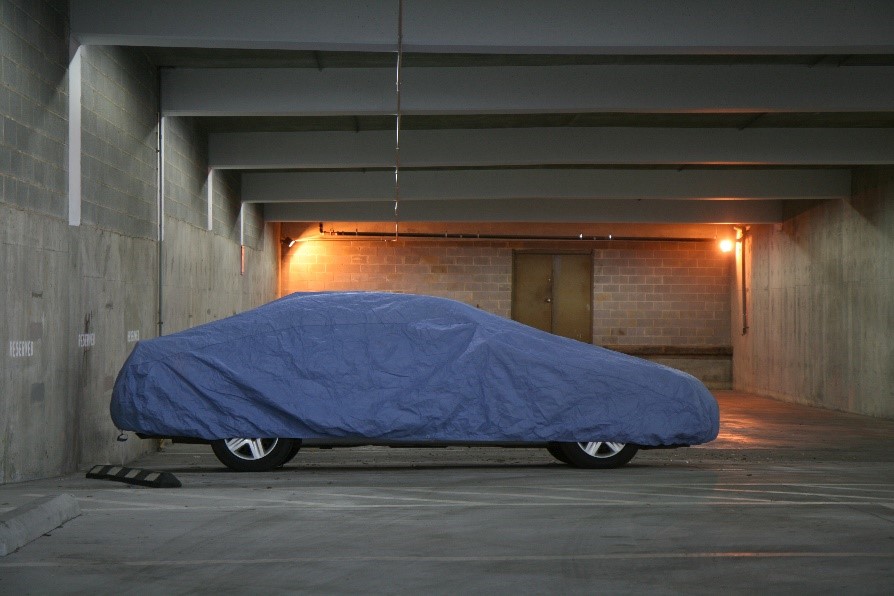By Lauren Fix, The Car Coach
If you don’t drive your favorite convertible, sports car, or classic in the cold, snow, and ice, proper winter car storage can prevent problems that can be costly to fix. A storage mistake could lead to blemishes, rust on your paint job, mechanical problems, or even rodents taking up a new home in your tailpipe.
Make Sure your Car is Insured
It’s essential to protect your car with standard car insurance or classic car insurance, even when it’s in storage. There are several reasons to avoid letting your policy lapse even when you’re not driving the car.
First, a gap in coverage could cause your premium to increase once you’re ready to reinsure your car. Second, if something happens to your car while it’s in storage (such as fire, theft, or rodents), insurance can help cover the repairs costs.
It’s a good idea to maintain your comprehensive coverage, as long as you don’t plan to drive your car, you can drop your collision coverage until you are driving again. Make sure that you update your storage location with the insurance company.

Credit: Ildar Sagdejev
Decide where to Store your Car
If possible, store your car in a dry location with a concrete floor, such as your garage or an indoor storage unit. Many self-storage facilities offer indoor and/or outdoor vehicle storage options. You can safely store your car in the elements for several months if you cover it properly. However, if you need to store your car for years, it definitely should be kept inside.
Swap out Fluids
Leaving dirty, used oil in your car can cause engine damage. Therefore, if you plan to store your car for a month or more, have the oil changed. I highly suggest full synthetic oils as they don’t breakdown like regular oil.

Fill up the Tank
Before storing your vehicle, use up most of the fuel, add StaBil then fill up the tank before storage. Topping off the tank keeps water out and seals lubricated. This action will extend the life of your gasoline and stop potential damage known as “varnishing” that can plug up your fuel injectors and cost hundreds of dollars to clean.
Protect your Battery
It’s best to have your stored vehicles on a trickle charger or battery maintainer. This inexpensive device helps your battery maintain power instead of gradually losing it over time. If you let it sit for more than six months, you’re more than likely going to have a dead battery. Save yourself the hassle and possibly the cost of towing, which typically costs around $40.
Take Care of your Tires
Tires can lose pressure over time when there are temperature changes. Loss of tire pressure can lead to “flat spots” on the bottom of the tires. Flat spots can ruin your tires, which means you will need to spend hundreds of dollars replacing them. To ensure your tires remain in good repair, remove them and use jack stands to hold your car off the ground.

Keep Critters Away
Put a rubber ball or rag in the tailpipe to prevent mice or insects from setting up shop there. Also, cover heater vents or other openings that could provide access to cozy nesting spaces. As a third precaution, place dryer sheets in the vehicle to drive away critters.
Wash that Ride
Wash your car to remove bird droppings, tree sap, or other substances that could damage your car’s paint. Make sure to clean the tires to get rid of dirt and grease as well. Apply a coat of wax to your car to protect its exterior while it’s stored. That way, in spring, you’ll have a nice clean car, ready to go.
Get a Pad to Soak up Leaks
Certain vehicles leak fluid while sitting. Use cardboard or buy an absorbent mat designed to be placed underneath a car during storage to keep leaks from staining the driveway, garage, or storage space floor.
Cover your Car
Whether your car is sitting in your driveway, your garage, or a special storage facility, you should keep it covered while you’re away. Use a good quality car cover that breathes, not a plastic tarp that traps moisture. If your car will be stored outside, you’ll need a weatherproof car cover to protect it from rain, sleet, and snow.

When spring arrives, and it’s time to drive your car again, first, remove the ball or rag from your tailpipe. Disconnect the trickle charger and put that car cover in a safe, clean spot.
Some people want the peace of mind that comes with extended warranties, so this is something you might want to consider unless the car is still under the manufacturer’s warranty or is a CPO vehicle. Do your research and check out places like carwarrantyguru.com.
Lauren Fix, The Car Coach®, is a nationally recognized automotive expert, analyst, author, and television host. A trusted car expert, Lauren provides an insider’s perspective on a wide range of automotive topics and aspects, energy, industry, consumer news, and safety issues.
Lauren is the CEO of Automotive Aspects and the Editor-in-Chief of Car Coach Reports, a global automotive news outlet. She is an automotive contributor to national and local television news shows, including Fox News, Fox Business, CNN International, The Weather Channel, Inside Edition, Local Now News, Community Digital News, and more. Lauren also co-hosts a regular show on ABC.com with Paul Brian called “His Turn – Her Turn” and hosts regular radio segments on USA Radio – DayBreak.
Lauren is honored to be inducted into the Women’s Transportation Hall of Fame and a Board Member of the Buffalo Motorcar Museum and Juror / President for the North American Car, Utility & Truck of the Year Awards.
Check her out on Twitter and Instagram @LaurenFix.
Editor’s Note: The opinions expressed in this article are those of the author.








I had some sort of rodent built a nest in the squirrel cage blower for the ventilation system in my 1990 Plymouth Laser Turbo. Fortunately it is extremely to access the blower under the dash. It was comical that spring. Start up the car, and immediately the blower roared from being unbalanced, and all sorts of dry grass bits and loose fur blew out of the dash vents. I know right then what had happened.